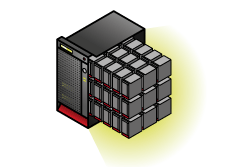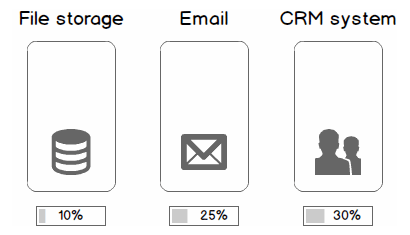What is virtualisation and can it help your business?
 Virtualisation technology allows you to slice up a single server and use each bit for a different task. It can help your company do more with fewer servers, reducing costs and making you more efficient
Virtualisation technology allows you to slice up a single server and use each bit for a different task. It can help your company do more with fewer servers, reducing costs and making you more efficient
Virtualisation technology explained
Virtualisation technology lets your business to take a single server, then divide it into several virtual servers with the help of special software.
This allows a single physical server to function like several individual servers. You can then use it do several jobs at once.
Here's how it works.
Traditionally, businesses have used separate servers for separate tasks.
You might have one server to handle your email, making sure messages enter and leave your business correctly.
You might use a second server for file storage. Its job is to make sure that your employees have a safe place to store important files.
Your third server runs your customer relationship management (CRM) system, so you can keep track of communications with your customers.
The thing is, modern network servers are very powerful. That means none of your three servers is used to its full capacity:

As you can see, a single server could easily handle all that work. But you don't usually run lots of software on a server because different applications can interfere with each other.
If you need to restart the server to install an update or fix a crash, that will also interrupt all applications.
With virtualisation technology, you use special software to create virtual servers from a single physical server.
Each of these virtual servers behaves exactly as if it were a separate physical server. It has its own operating system and you can restart it without interrupting the other virtual servers.
And that means you can make much better use of a single, physical server:

Why use virtualisation technology?
There are three main benefits to using virtualisation technology in your business:
- It’s cheaper. Because virtualisation enables you to do several different jobs with one physical server, you don't need to buy and run as much server hardware.
- Scalability. Virtualisation technology can split tasks between more than one piece of hardware. This means it’s very easy to add extra capacity, should you need to.
- Agility. Virtual servers can be set up and changed faster, making it easier for your business to respond to changing demands or requirements.
If you’re considering investing in new servers or new software to run on them, the argument for virtualisation is compelling. You get more flexibility, better reliability … and it means your IT systems are more efficient.
Don’t skimp on virtualisation backups
In the rush to adopt virtualisation technology, many companies are falling short when it comes to protecting their data.
A survey by Acronis – the company I work for – found that a third of businesses do not back up virtual severs as often as their physical ones. Just under half only back up virtual machines weekly or monthly.
If your business falls into that category, your data is at risk. That’s because virtual servers are subject to the same risks as traditional servers, like hard drive failure, software failure and human error.
While adopting virtualisation may not mean there are any changes to how people use your IT day-to-day, backup and recovery of virtual servers can be a pain point.
It’s therefore vital you protect your data with regular backups, plus a tried and tested disaster recovery and business continuity strategy. Work with your IT supplier to find a disaster recovery solution that’s simple and easy to use, even with minimal training.
Make the most of virtualisation technology
Virtualisation presents an excellent opportunity to make your business IT more efficient. It could save you cash and make it easier for you to change direction quickly or respond to new opportunities.
Indeed, if you’re replacing one or more servers, or investing in servers for the first time, there are few good arguments against virtualisation. Just make sure you work closely with an IT supplier you trust, and make sure you understand what would happen in the event of a problem like a system crash.
- How we replaced our stretched servers with virtualisation
- Q&A: how to benefit from network server virtualisation
- Virtual server hosting




